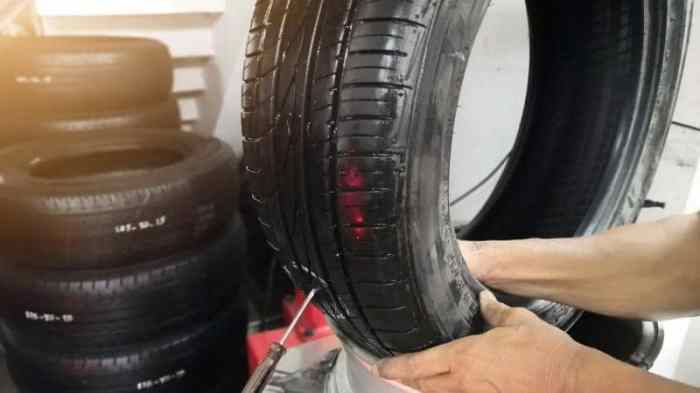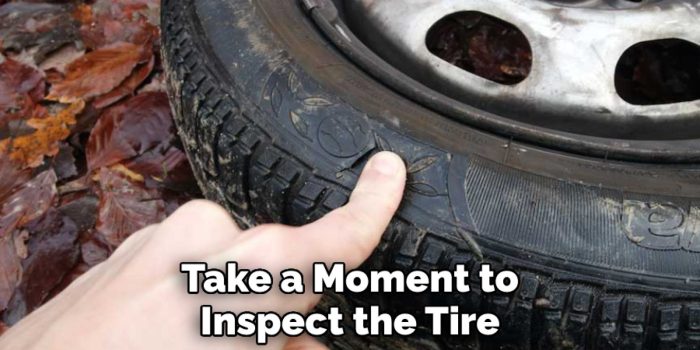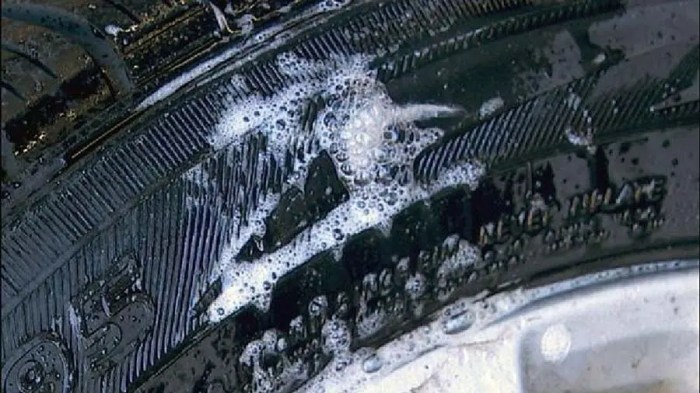How to fix a slow tire leak? It’s a question that’s plagued drivers for ages. Nobody wants to be stranded on the side of the road, especially when it’s easily avoidable! This guide breaks down everything you need to know, from spotting that sneaky puncture to deciding whether to patch it up or grab a new tire. We’ll cover the basics, show you some DIY fixes, and help you avoid future flat tire drama.
We’ll walk you through identifying the leak’s source – think soapy water detective work! – and then assess how serious it is. From there, we’ll tackle temporary fixes (think sealant) and more permanent solutions (patching). We’ll even help you decide when a replacement tire is the smarter move. Get ready to become a tire-troubleshooting pro!
Identifying the Leak Source
Pinpointing the source of a slow leak can be tricky, but with the right approach, you can usually find it. A slow leak often means the puncture is small, making it harder to spot with the naked eye. Common locations and effective inspection methods will significantly increase your chances of success.
Common Leak Locations
Slow leaks frequently originate in the tire’s tread area, where it’s most exposed to road debris like nails, screws, and glass shards. Sidewall punctures are less common for slow leaks because the sidewall is more flexible and often seals itself partially, resulting in a quicker, more noticeable deflation. However, sidewall leaks can still occur, often from small cuts or embedded objects.
The bead area (where the tire meets the rim) is another potential, though less frequent, source of slow leaks. Improper tire installation or damage to the bead can cause air to escape.
Visual Inspection of the Tire
Thoroughly examine the entire tire, starting with the tread. Look closely for any embedded objects—nails, screws, pieces of glass, or even small stones that might have pierced the tire. Pay special attention to any areas that appear discolored, bulged, or otherwise abnormal. Rotate the tire slowly, examining each section carefully under good lighting. A flashlight can be helpful for getting a better look in the tire grooves.
Inspect the sidewalls for cuts, abrasions, or any signs of damage. Remember to check the bead area where the tire meets the rim, looking for any irregularities or damage that could be causing a leak.
Using Soapy Water to Locate a Leak
This is a very effective method. Mix a solution of soapy water—dish soap works well—in a spray bottle. Thoroughly wet the entire tire surface with the soapy solution, paying close attention to the tread, sidewalls, and bead area. Look for any bubbles that form. Bubbles indicate escaping air, thus pinpointing the leak.
If you find a leak in the tread, you may need to carefully rotate the tire to locate the exact point of the leak as small bubbles can be difficult to see. If the leak is substantial, you’ll see large, rapidly forming bubbles. Small leaks might only show tiny, slow-forming bubbles, so be patient and methodical.
Comparison of Leak Detection Methods
| Method | Advantages | Disadvantages | Effectiveness |
|---|---|---|---|
| Visual Inspection | Quick, inexpensive, no special tools needed | Only effective for larger punctures or obvious damage; may miss small leaks | Moderate |
| Soapy Water Test | Highly effective for locating even small leaks; inexpensive and easy | Requires some time and patience; can be messy | High |
| Tire Pressure Monitoring System (TPMS) | Provides continuous monitoring of tire pressure; alerts you to slow leaks | Requires TPMS sensors; can be expensive to install | High (for detection, not precise location) |
| Professional Tire Shop | Accurate leak detection; often includes repair; experienced technicians | Can be expensive; requires transporting the tire | Very High |
Assessing the Severity of the Leak
Okay, so you’ve found the leak. Now, how bad is it, really? Understanding the severity is key to deciding how to fix it – a slow leak might just need a sealant, while a fast one demands immediate professional attention.Determining the severity involves understanding the different types of leaks and how quickly your tire is losing air. This isn’t rocket science, but a little methodical observation goes a long way.
Types of Tire Leaks and Their Characteristics
Tire leaks range from barely noticeable slow leaks to dramatic, rapid deflations. Slow leaks are often caused by small punctures, slow valve stem leaks, or gradual permeation of air through the tire’s rubber over time. These leaks might only cause a noticeable drop in pressure over several days or even weeks. Fast leaks, on the other hand, result from larger punctures, significant valve stem damage, or major sidewall tears.
These can deflate a tire completely within minutes. The difference is significant and dictates your next steps.
Measuring Air Loss Rate
There are a couple of ways to gauge how quickly your tire is losing air. The simplest is to use a tire pressure gauge. First, fully inflate the tire to its recommended pressure (found on the tire sidewall or your vehicle’s owner’s manual). Record the pressure. Then, wait a specific amount of time (e.g., 24 hours) and measure the pressure again.
The difference represents the air loss. For example, if the pressure dropped from 35 PSI to 30 PSI in 24 hours, that’s a 5 PSI drop per day – a relatively slow leak. If it drops 10 PSI or more in a few hours, that’s a fast leak needing immediate attention. Another method involves using a soapy water solution (as described in the previous section) to locate the leak and observe the rate of bubble formation.
More rapid bubbling indicates a faster leak.
Implications of Different Leak Severity Levels
A slow leak, as described above (a few PSI loss per day), might be manageable with a tire sealant. It might be a small puncture that seals itself with the sealant. However, if the slow leak persists after using sealant, or if the leak is in the sidewall, a professional tire repair or replacement might be necessary. A moderate leak (significant pressure loss over a few hours) often requires professional attention.
While a sealant might temporarily work, a more permanent solution is likely required. A fast leak (rapid pressure loss) is a serious safety hazard. Driving on a rapidly deflating tire can cause a crash. Immediate professional help is needed, you should not attempt to drive on it.
Decision-Making Flowchart Based on Leak Severity
To help visualize the decision-making process, consider this flowchart:
Start -> Measure Air Loss -> Is Air Loss Yes: Try Tire Sealant -> Did Sealant Work? -> Yes: Monitor Pressure -> No: Professional Repair/Replacement -> No: Is Air Loss Yes: Professional Repair/Replacement -> No: Immediate Professional Assistance/Do Not Drive
So, you’ve got a slow tire leak? That’s annoying, but usually fixable with a tire sealant or a patch kit. Sometimes, though, a persistent leak might mean something’s up with your car’s overall maintenance – maybe it’s time to check your owner’s manual or even look up how to reset that pesky maintenance light, like this guide shows you how to How to reset maintenance light on Toyota Camry.
Getting that light sorted might help pinpoint if there’s a bigger issue impacting your tire pressure. Anyway, back to that slow leak – make sure to check your tire pressure regularly!
Temporary Repair Methods

Okay, so you’ve found the leak and assessed the damage. Now what? Sometimes, a full tire repair isn’t immediately feasible, especially if you’re miles from a tire shop. That’s where temporary repair methods come in handy. These aren’t permanent fixes, but they can get you to a safe place to get a proper repair.
So, you’ve got a slow tire leak? That’s annoying. First, try finding the puncture; sometimes it’s just a small nail. If you can’t fix it yourself, you might need a new tire, freeing up some cash for other car maintenance like figuring out the Best coolant for Honda Accord 2025 , which is crucial for preventing overheating.
After you’ve dealt with the coolant, get back to that tire – a slow leak can still be dangerous, so don’t put it off!
Remember, safety first!Using a tire sealant is the most common temporary fix for slow leaks. These products are designed to plug small punctures and slow air loss, buying you some time. They typically come in aerosol cans or bottles, and application varies slightly depending on the product.
Tire Sealant Application
Most tire sealants require you to shake the can vigorously before use. Then, you’ll need to remove the valve core from your tire valve (using a valve core removal tool – see emergency supplies below). This allows the sealant to enter the tire easily. After inserting the sealant applicator nozzle into the valve stem, you’ll follow the product’s instructions to add the sealant.
After adding the sealant, you’ll need to inflate the tire to the recommended pressure and drive the vehicle for a short distance to distribute the sealant. It’s important to follow the specific instructions provided by the manufacturer of your chosen tire sealant as methods and precautions vary slightly. Always refer to the specific product’s instructions.
Limitations and Drawbacks of Temporary Repairs
Temporary repairs, while helpful in emergencies, are exactly that – temporary. Sealants won’t fix larger punctures, embedded objects, or significant sidewall damage. Using a sealant might also damage your tire pressure monitoring system (TPMS), and it may not be compatible with all tire types. Furthermore, driving on a tire with a sealant is generally not recommended for extended periods or at high speeds.
Think of it as a short-term solution to get you out of a jam, not a long-term fix. For instance, you might safely drive 50 miles to a tire shop, but you shouldn’t plan on a cross-country road trip relying on a tire sealant.
Types of Tire Sealants, How to fix a slow tire leak
The market offers several tire sealant types. Some are designed for tubeless tires only, while others claim to work on both tube-type and tubeless tires. They vary in viscosity and the types of sealants used. Some are primarily liquid sealants, while others incorporate fibrous materials for enhanced sealing capabilities. You’ll find sealants marketed for specific types of punctures or for different driving conditions.
Always check the product label for compatibility with your tire type and the severity of the leak. For example, a sealant designed for small punctures might not be effective for a larger hole caused by a sharp object.
Emergency Tire Repair Supplies
It’s always a good idea to keep a small kit in your car for tire emergencies. This kit should include:
- Tire sealant (choose one compatible with your vehicle)
- Valve core removal tool
- Tire pressure gauge
- Gloves
- Flashlight
- Small rag or towel
- Owner’s manual (for your vehicle’s tire inflation recommendations)
Having these items readily available can significantly improve your ability to handle a slow leak safely and efficiently. Remember, this kit is for temporary repairs only. A proper tire repair or replacement is still necessary as soon as possible.
Permanent Repair Methods
Okay, so you’ve identified the leak and maybe even tried a temporary fix. Now it’s time for the real deal: a permanent tire patch. This is a more involved process than a quick plug, but it’ll give you a much more reliable and lasting repair. Remember, safety first! Always work in a well-ventilated area and wear appropriate safety gear.
Patching a tire from the inside involves inserting a specialized patch into the hole from the inside of the tire, effectively sealing the puncture. This method is generally more durable and reliable than external patching, especially for larger punctures. It requires a bit more skill and the right tools, but the result is a significantly stronger repair.
Tools and Materials Required for Permanent Tire Repair
Before you begin, gather your supplies. You’ll need a few things: tire repair kit (containing patches, cement, rasp, and tire irons), a valve core remover tool, a source of compressed air, a bucket of soapy water, and possibly a jack and lug wrench if you’re working on a vehicle. The repair kit itself usually contains everything you need for the patching process.
Make sure to choose a kit appropriate for the size of the puncture.
Removing Embedded Objects from a Tire
Before patching, carefully remove any embedded object. Use pliers or tweezers to gently grasp the object and pull it straight out. Avoid twisting or wiggling it, as this can enlarge the hole. If the object is firmly lodged, a small, sharp tool (like a tire rasp) can be carefully used to free it. Once removed, inspect the hole.
If it’s larger than ¼ inch, a professional repair is recommended.
Step-by-Step Guide for Patching a Tire Puncture
- Image 1: Preparing the Tire. The image shows the tire removed from the wheel, lying on a clean, flat surface. The puncture is clearly visible and marked. The surrounding area of the tire is clean and dry.
- Image 2: Cleaning the Puncture. The image shows the puncture site being cleaned thoroughly with the rasp. The rasp is carefully used to remove any debris or damaged rubber around the hole, creating a clean, slightly tapered surface for better patch adhesion.
- Image 3: Applying the Cement. The image depicts the application of tire cement to the inside of the puncture. A thin, even layer of cement is carefully applied to the hole, ensuring complete coverage. This step is crucial for the patch’s adherence.
- Image 4: Applying the Patch. The image shows the patch being carefully pressed firmly onto the cemented area. The patch is positioned to completely cover the puncture and is pressed down firmly, ensuring complete contact with the cement.
- Image 5: Patching Complete. The image shows the completed patch. The patch is securely attached and there are no visible gaps or imperfections. The surrounding tire area is clean and free from excess cement.
- Image 6: Re-installing the Tire. This image shows the patched tire being carefully reinstalled onto the wheel. The tire beads are properly seated into the wheel rim, ensuring a tight and secure fit.
- Image 7: Inflating the Tire. The image shows the tire being inflated to the correct pressure using a reliable air compressor. The tire is carefully monitored for any leaks or imperfections during inflation.
When to Replace a Tire
Knowing when to replace a tire, rather than just repair it, is crucial for your safety and the longevity of your vehicle. Ignoring significant tire damage can lead to accidents and costly repairs down the line. This section Artikels situations where replacement is necessary and the factors to consider when choosing a new tire.Tire damage beyond simple punctures often necessitates replacement.
The structural integrity of the tire is paramount, and attempting to repair severely damaged tires is unwise and potentially dangerous.
Tire Damage Requiring Replacement
Certain types of tire damage are irreparable and pose significant safety risks. These include:
- Sidewall damage: Sidewalls are crucial for tire stability and strength. Even small cuts or bulges in the sidewall compromise its structural integrity and cannot be reliably repaired. Imagine a deep gash in the sidewall – the rubber is essentially torn, weakening the tire’s ability to support the vehicle’s weight and handle turns safely. This is a clear indication for immediate tire replacement.
- Significant tread wear: While tire tread depth can be measured, visual inspection is important. When the tread wear indicators—small bars within the tread grooves—are flush with the tire surface, it’s time for replacement. Driving on severely worn tires dramatically reduces traction, especially in wet or icy conditions. Think of a bald tire: its grip on the road is minimal, increasing the stopping distance significantly and making the vehicle more susceptible to skidding.
- Embedded objects: While small objects like nails can sometimes be repaired, larger objects like screws or pieces of metal embedded deep into the tire’s tread or sidewall often cause irreparable damage. The embedded object can compromise the structural integrity of the tire, leading to unpredictable failures. Picture a large chunk of metal lodged deep within the tread – it’s likely to cause significant internal damage that’s not easily detectable.
- Bulges or bumps: These are often indicators of internal damage, possibly from impact or prolonged exposure to heat. A bulge or bump in the tire’s sidewall or tread represents a weakened area that is extremely vulnerable to failure. Imagine a balloon starting to bulge – the same principle applies here. The weakened area is under immense pressure and could burst at any time.
- Age: Even without visible damage, tires age and degrade. The rubber compounds lose their elasticity and strength over time, increasing the risk of failure. Check the sidewall for the date code (a four-digit number indicating the manufacturing week and year) to determine the tire’s age. Tires generally should be replaced after 6-10 years, regardless of tread depth.
Safety Implications of Driving on a Damaged Tire
Driving on a damaged tire significantly increases the risk of accidents. Loss of control, tire blowouts, and reduced braking ability are all potential consequences. A blowout, for instance, can cause a sudden loss of control, leading to a potentially fatal crash. Reduced braking distance in wet or icy conditions due to worn treads significantly increases the risk of collisions.
The safety of yourself and others on the road should be the primary consideration.
Factors to Consider When Choosing a Replacement Tire
Selecting a replacement tire involves several factors:
- Tire size: The size of your tire is crucial and is specified on the sidewall of your existing tire (e.g., P225/70R15). Using the incorrect size can negatively impact your vehicle’s handling and performance.
- Tire type: Different tire types (all-season, summer, winter, performance) are designed for different driving conditions. Choose a tire appropriate for your climate and driving habits.
- Tire rating: Tire ratings (speed rating, load index) indicate the tire’s maximum speed and load-carrying capacity. Ensure the replacement tire meets or exceeds the vehicle manufacturer’s recommendations.
- Price and warranty: Consider the cost of the tire and the warranty offered by the manufacturer. A longer warranty can provide peace of mind.
Preventing Future Leaks: How To Fix A Slow Tire Leak

So, you’ve fixed your slow leak. Good job! But let’s talk about preventing this from happening again. Proactive tire maintenance is key to avoiding costly repairs and, more importantly, ensuring your safety on the road. Regular checks and smart driving habits can significantly reduce your risk of punctures and slow leaks.Regular tire maintenance is crucial for extending the lifespan of your tires and preventing unexpected issues like slow leaks.
Neglecting your tires can lead to premature wear, reduced fuel efficiency, and, in severe cases, accidents. A little preventative care goes a long way.
Regular Tire Inspections
Performing regular visual inspections of your tires is a simple yet highly effective way to prevent future leaks. Look for embedded objects, cuts, bulges, or any signs of unusual wear. Early detection of potential problems allows for timely intervention, preventing minor issues from escalating into major repairs.
- Check tire pressure at least once a month, and before long trips. Use a reliable gauge and inflate to the recommended pressure listed on the tire sidewall or in your vehicle’s owner’s manual. Underinflation increases the risk of punctures and uneven wear.
- Inspect the tread depth using a tread depth gauge or the penny test (insert a penny into the tread; if you can see Lincoln’s head, it’s time for new tires).
- Examine the sidewalls for any cuts, cracks, bulges, or embedded objects. Look carefully for any signs of damage, no matter how small.
- Check for any unusual wear patterns. Uneven wear could indicate a problem with your vehicle’s alignment or suspension.
Avoiding Punctures
While you can’t completely eliminate the risk of punctures, you can significantly reduce your chances by practicing safe driving habits and being mindful of your surroundings.
- Avoid driving over potholes, debris, and sharp objects whenever possible. This seems obvious, but it’s amazing how often drivers overlook this.
- Be cautious when driving in construction zones or areas with a lot of road debris. Reduce your speed and maintain a safe following distance.
- Regularly check your tires for embedded objects. Even small objects like screws or nails can cause slow leaks if left untreated.
- Consider using tire sealant. Tire sealant is a liquid that seals small punctures as they occur, preventing slow leaks from developing. This is a preventative measure, not a replacement for regular tire inspections.
Tire Pressure Monitoring Systems (TPMS)
TPMS are electronic systems that monitor your tire pressure and alert you if it drops below a certain level. Many modern vehicles come equipped with TPMS, and they are a valuable tool for preventing slow leaks and ensuring optimal tire performance. A TPMS provides early warning, allowing you to address a pressure issue before it leads to significant damage or a blowout.
For example, a slow leak might not be noticeable during a visual inspection, but a TPMS will alert you to the pressure drop. This allows you to inflate the tire or address the leak promptly, preventing further damage.
End of Discussion

So, you’ve mastered the art of fixing a slow tire leak! Whether you’re patching a puncture yourself or knowing when to call in the pros, you’re now equipped to handle flat tire situations with confidence. Remember, regular tire maintenance is key to preventing these headaches. Keep an eye on your tire pressure, watch out for those pesky nails and glass shards, and you’ll be cruising down the road, worry-free.
Happy driving!









